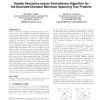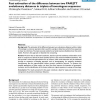654 search results - page 2 / 131 » On the Approximation of Computing Evolutionary Trees |
DAM
2007
13 years 4 months ago
2007
It is now well-documented that the structure of evolutionary relationships between a set of present-day species is not necessarily tree-like. The reason for this is that reticulat...
SAC
2003
ACM
13 years 10 months ago
2003
ACM
Given a connected, weighted, undirected graph G and a bound D, the bounded-diameter minimum spanning tree problem seeks a spanning tree on G of lowest weight in which no path betw...
BMCBI
2007
13 years 5 months ago
2007
Background: Although testing for simultaneous divergence (vicariance) across different population-pairs that span the same barrier to gene flow is of central importance to evoluti...
EVOW
2005
Springer
13 years 10 months ago
2005
Springer
Computing consensus trees amounts to finding a single tree that summarizes a collection of trees. Three evolutionary algorithms are defined for this problem, featuring characteri...
BMCBI
2006
13 years 5 months ago
2006
Background: The estimation of the difference between two evolutionary distances within a triplet of homologs is a common operation that is used for example to determine which of t...


